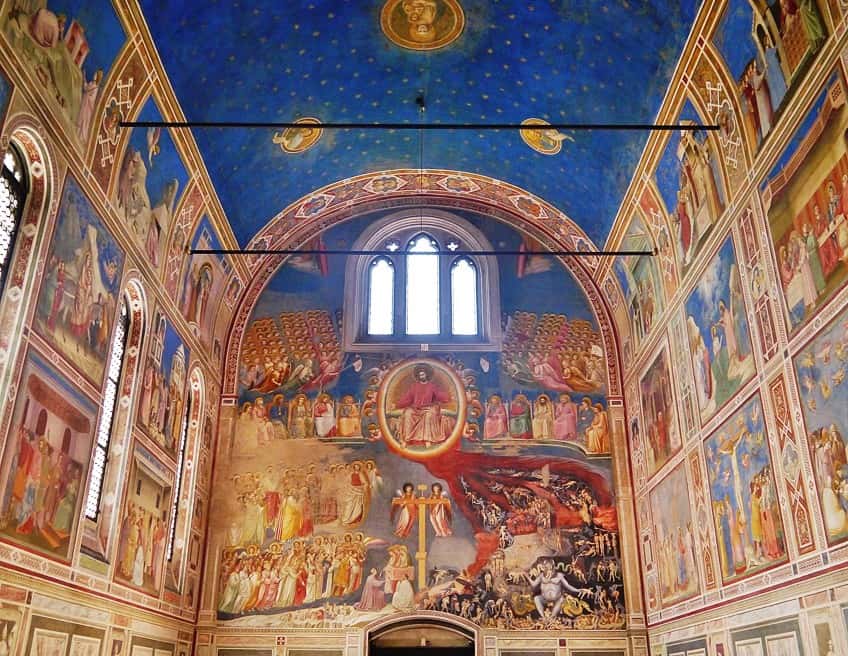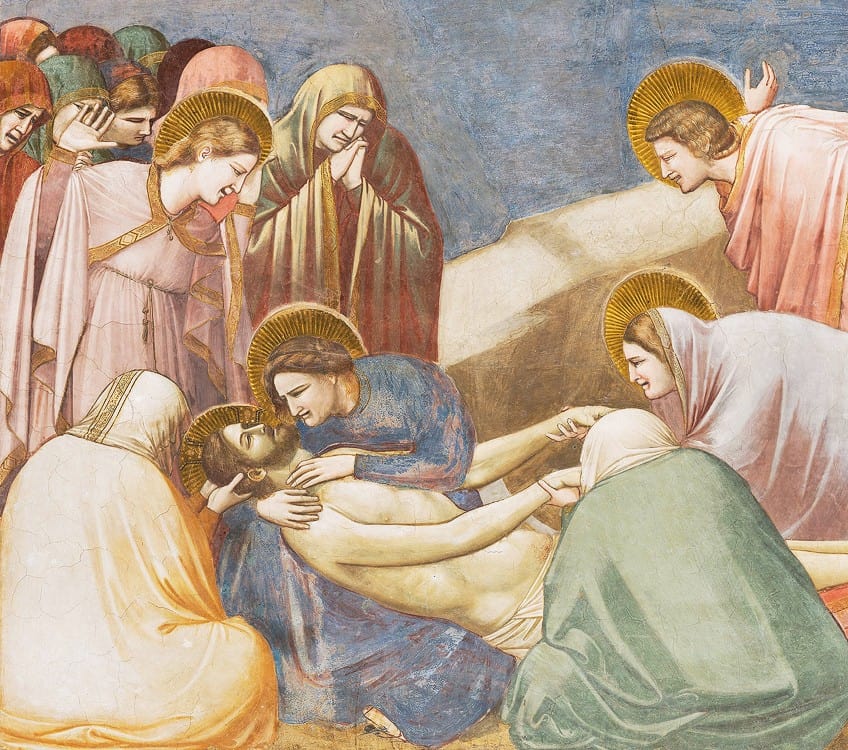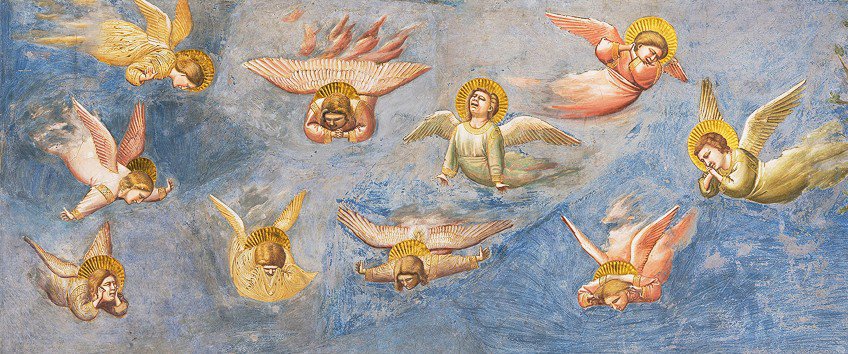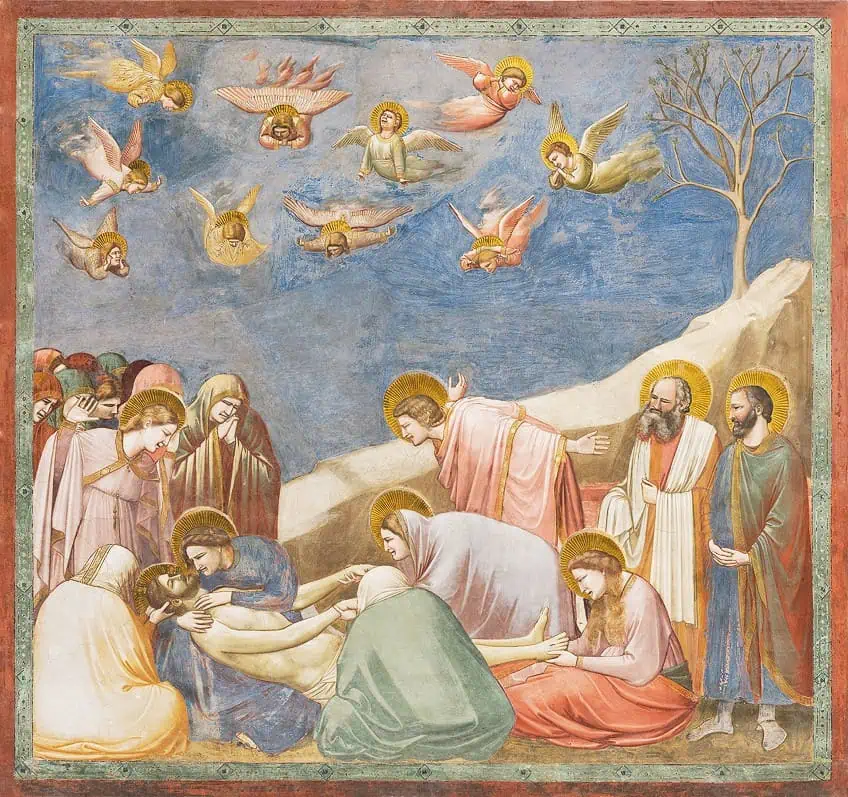“Lamentation of Christ” by Giotto di Bondone – A Quick Analysis
The Lamentation of Christ by Giotto di Bondone portrays what happened following Jesus’ crucifixion, as his body was prepared for burial by the mourning gathering of people. The lamentation painting focuses on Jesus, who is encircled by the grieving masses, as angels fly above. In this article, we will take a look at Giotto’s Lamentation analysis and find out more about the production and history of this painting.
Contents
Exploring the Lamentation of Christ by Giotto di Bondone
| Artist | Giotto di Bondone (1266 – 1337) |
| Date | c. 1304 |
| Medium | Fresco |
| Dimensions (cm) | 200 x 200 |
| Location | Scrovegni Chapel, Padua, Italy |
In art history, the Lamentation of Christ has been a prevalent and prominent motif. In Christian theology, the Lamentation scene, which shows those mourning over Christ’s corpse after his crucifixion, has immense spiritual importance. Many different artists have represented the Lamentation of Christ in different ways throughout the history of Western art, encompassing sculptures, paintings, and other visual arts.
The subject matter has been addressed by artists of many eras, genres, and cultural origins, which has produced a wide range of interpretations and aesthetic approaches.

Hans Holbein the Younger, Rogier van der Weyden, Caravaggio, Andrea Mantegna, Peter Paul Rubens, and others have all depicted the Lamentation of Christ theme. Each of these artists approached the subject with their own style, points of view, and interpretation. The Lamentation painting by Giotto di Bondone is a renowned early rendition of this popular theme.
Giotto’s representation in the Scrovegni Chapel was a notable break from Byzantine artistic tradition and had an enormous influence on succeeding painters.
The Scrovegni Chapel
The Scrovegni Chapel is a tiny church in Padua, Italy. It is famous for a spectacular cycle of paintings produced in the early 14th century by Giotto di Bondone. Enrico Scrovegni, a rich banker, originally commissioned the chapel to serve as his exclusive family chapel devoted to the Virgin Mary. The chapel’s construction started in 1303 and was finished in around 1305. Because it is located near a historic Roman amphitheater, it is also known as the Arena Chapel.
The Scrovegni Chapel’s interior is ornamented with a beautiful cycle of paintings produced by Giotto Di Bondone. The frescoes adorn the whole top portion of the walls, as well as the triumphal arch and vaulted roof.
The chapel frescoes are regarded as among the most significant artistic works of the early Renaissance era. Giotto di Bondone’s paintings transformed the style and attitude of art, deviating from the Byzantine tradition’s flat and stylized figures. His characters have volume, expressiveness, and three-dimensionality, establishing a new standard for lifelike portrayal. Giotto’s fresco cycle presented a groundbreaking style of realism that featured more lifelike characters and emotions. The traditional style of medieval art, as practiced, for instance, by the Sienese School of painting, seemed wooden and out of date.

The Scrovegni Chapel paintings are made up of 39 consecutive scenes depicting the lives of Christ and Mary. The general iconographic subject is Christian Redemption, most likely because the chapel was supposed to atone for the Scrovegni family’s crimes as a consequence of their money lending operations. Additionally, the Last Judgment is shown on the wall around the chapel’s entrance. The Lamentation painting is one of the most iconic and emotionally compelling murals in the Scrovegni Chapel. It is a component of the Life of Christ portion and exemplifies the artist’s outstanding ability to capture human sadness and sorrow.
Giotto di Bondone is genuinely enthusiastic about dramaturgy. It is crucial for him to demonstrate the emotional significance of what is happening, as well as how the participants of the evangelical occurrences express their sorrow in various ways.
The Virgin Mary’s grieving is quiet and introspective. In despair and sorrow, women wring their hands. Mary Magdalene weeps at Christ’s feet. Stoics share Nicodemus’ and Joseph Arimafesky’s grief. And the widely diverging hands of John the Divine, the Savior’s favored disciple, are both suggestive of the cross and of something birdlike.
Giotto’s Lamentation Analysis
The Lamentation is typically shown with Jesus’ body, having been taken from the cross, being grieved by friends and relatives. Biblical individuals are often distinguished by their halos in the pictorial iconography of the period. The Lamentation had become a popular theme by the 11th century, with Jesus and Mary at the center of the scene. In Giotto di Bondone’s Lamentation painting, five figures encircle and create an arc around the body of Christ, which, as we are able to see, isn’t touching the ground.
Three of the characters are females with halos and wearing biblical garments and are cradling his body. Two others have their backs to the viewer. Two people raise the hands of Jesus aloft. Mary Magdalene, with her beautiful red hair, sits at Jesus’ feet.
Mary is cradling the head of Jesus as well as the upper torso, her own head in close proximity to his. Three males are seen in the painting’s central ground on the right side. One, on the left, is most likely St. John the Apostle, who is often portrayed clean-shaven with short hair, and youthful, in addition to having a halo. He surrenders completely to his sorrow, arms extended and body tilting towards Jesus. The other two figures behind St. John, the only people that seem calm, are most likely Nicodemus and Joseph of Arimathea, who are specifically acknowledged in the Gospels as being present.

The composition is divided by a rocky mountain range, which focuses our attention on Jesus and Mary. The tree in the backdrop is most likely the Tree of Knowledge of Evil and Good, which has been barren since the Fall of Man and serves as a reminder of original sin. There are 11 angels, shown in various states of sadness, depicted in the sky. In fact, one might say that heaven and earth are mourning together in this artwork. The human beings and architectural spaces are not stylized in the Byzantine fashion of Giotto di Bondone’s contemporaries such as Cimabue or Duccio.
There is an impression of three dimensions, if somewhat more compressed than in pictures from a few centuries later.
The human figures are given far more three-dimensionality than usual, and Giotto di Bondone also produces a realistic image of space, adding to the work’s impression of reality. These three factors – the authenticity of Giotto’s individuals and expressions, the sculpted nature of his individuals, and the “depth” he established in his paintings – defined an important turning point in painting and heralded the end of the old Byzantine art traditions, with their flat one-dimensional images.

The subdued pastel hues are characteristic of fresco painting; the blue azurite utilized in the sky, which was undoubtedly exceedingly captivating once upon a time, has similarly faded. The individuals are dressed naturally, and their facial and physical emotions are clearly expressive. The emotional and profoundly dramatic impact of Giotto’s work sets him apart from the rest of his contemporaries. Observe the degree of sadness, as well as the range of expressions in both the faces and bodily postures in the Lamentation painting.
The mourners’ feelings are mostly communicated through their hands and faces, particularly their trembling mouths. Their lowered heads and slumped bodies add to the overall sense of despondency in the piece.
The Importance of the Artist of the Lamentation Painting
Giotto di Bondone was an artist and architect from Italy. He is regarded as one of the most significant artists of the final years of the medieval era and played an important part in the shift from the Byzantine to the Italian Renaissance aesthetic traditions. Giotto’s most notable contribution to art, in general, was his move away from the Byzantine tradition’s flat, stylized figures. He pioneered a more realistic style of painting, focusing on three-dimensionality, volume, and reality. Their physiques had greater weight, their facial expressions and gestures were more emotive and genuine, and their feelings were expressed clearly.
Giotto di Bondone’s humanistic approach established the groundwork for the humanistic principles that would come to define the Renaissance.
Giotto di Bondone was regarded as an exceptional visual storyteller. His compositions were meticulously constructed to communicate a narrative sequence and emotionally engage viewers. He pioneered new approaches to depicting space, such as combining buildings and landscapes to produce depth and perspective in his works. His compositions were distinguished by an outstanding sense of coherence, order, and visual clarity, allowing viewers to comprehend and relate to the stories represented.

Giotto di Bondone was a skilled fresco artist, and his command of this medium added to his legacy. Frescoes involve painting straight on wet plaster and letting the colors cure on the surface of the wall. Giotto di Bondone’s frescoes in the Scrovegni Chapel and other sites demonstrated his ability to create radiant colors, smooth transitions, and long-lasting artworks. His realistic technique, emphasis on human emotions, and narrative storytelling spread throughout Europe, influencing the trajectory of Western art history.
That wraps up today’s article on the Lamentation of Christ by Giotto di Bondone, a fresco painting produced in the High Middle Ages. This famous Lamentation painting portrays the body of Jesus, the followers of Christ, and the angels flying overhead in the sky. It was part of the 37 Biblical scenes painted for the small family-owned Scrovegni Chapel in Padua, Italy. These frescoes were all completed around 1305, and are regarded as the artist’s magnum opus. Giotto’s Lamentation analysis reveals that these frescoes are held in such high regard because of the range of facial expressions and realism that they display. This would not only change the direction of Giotto’s own style and subsequent works, but also had a significant impact on other artists during the Italian Renaissance era.
Frequently Asked Questions
What Is the Lamentation Painting About?
There are actually many artworks that depict this popular Biblical theme. They portray the moment after Jesus was taken down from the cross and is being prepared for burial, surrounded by his loved ones and followers. The most renowned artwork to portray this scene is The Lamentation of Christ by Giotto di Bondone. It is the most well-known version because it played a significant role in changing the trajectory of Western art, due to its more life-like rendering of the figures and the range of expressions and poses displayed in the individuals.
Who Was Giotto di Bondone?
There is very little known about Di Bondone’s life, as the only written accounts come from Vasari, whose biographies have been heavily debated over their accuracy. Based on Vasari’s writings, Giotto di Bondone was the apprentice of one of the era’s top painters, Cimabue. It was from this painter that Di Bondone learned how to paint frescoes after following him to Assisi to help with various projects. He then went on to produce the frescoes for the Scrovegni Chapel, a small church owned by the Srovegni family. These frescoes would ultimately have a huge impact on art due to their diversion from the more flat Byzantine style that was prominent during that time.
Jordan Anthony is a Cape Town-based film photographer, curator, and arts writer. She holds a Bachelor of Art in Fine Arts from the University of the Witwatersrand, Johannesburg, where she explored themes like healing, identity, dreams, and intuitive creation in her Contemporary art practice. Jordan has collaborated with various local art institutions, including the KZNSA Gallery in Durban, the Turbine Art Fair, and the Wits Art Museum. Her photography focuses on abstract color manipulations, portraiture, candid shots, and urban landscapes. She’s intrigued by philosophy, memory, and esotericism, drawing inspiration from Surrealism, Fluxus, and ancient civilizations, as well as childhood influences and found objects. Jordan is working for artfilemagazine since 2022 and writes blog posts about art history and photography.
Learn more about Jordan Anthony and about us.
Cite this Article
Jordan, Anthony, ““Lamentation of Christ” by Giotto di Bondone – A Quick Analysis.” artfilemagazine – Your Online Art Source. October 19, 2023. URL: https://artfilemagazine.com/lamentation-of-christ-by-giotto-di-bondone/
Anthony, J. (2023, 19 October). “Lamentation of Christ” by Giotto di Bondone – A Quick Analysis. artfilemagazine – Your Online Art Source. https://artfilemagazine.com/lamentation-of-christ-by-giotto-di-bondone/
Anthony, Jordan. ““Lamentation of Christ” by Giotto di Bondone – A Quick Analysis.” artfilemagazine – Your Online Art Source, October 19, 2023. https://artfilemagazine.com/lamentation-of-christ-by-giotto-di-bondone/.



